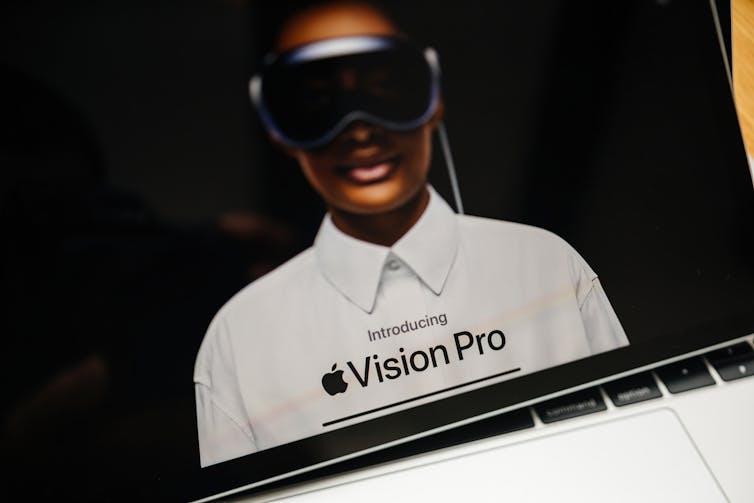Apple’s recent unveiling of the Vision Pro, its first augmented reality and virtual reality (VR) headset, came as a surprise to no one who follows Apple news – rumours had been circulating for years.
Apple’s products have a long history of creating waves well ahead of launch due to rumour and speculation. In late 2009, for example, the technology blog MacRumors.com suggested – without fully validated evidence – that Apple was going to call its upcoming tablet computer the “iSlate”. Other rumours about the device – some of which turned out to be correct – discussed possible features and the timing of its forthcoming release. Of course, the “iSlate” was finally launched by Apple in April 2010 as the iPad tablet.
A lack of solid information fuelled ambiguity, in that case, and the same has happened with Apple’s Vision Pro headset. By discussing issues like purpose, price and looks pre-launch, consumers and competitors start to develop ideas about products, and perhaps even what accessories or apps will be needed alongside them. They also start to develop thoughts about how the market – or even consumers’ lives – could change as a result. All with often little to no solid information.
Academic research classifies a rumour as information passed from one person to another with “a lack of secure standards of evidence”. Rumours are forms of information with an uncertain status when it comes to truth – they are sometimes not even true or false yet.
Rumours generally start any time there is ambiguity about future events. So product innovation rumours speculate on forthcoming products or updates. The source could be someone like a contributor to an online technology blog, but it could also come from within a company itself.
It may appear paradoxical for an innovative firm such as Apple to leak new design products – but these rumours can elevate share prices, test industry and consumer reaction, and preempt competitor moves. Other companies – competitors or those developing accompanying products and services – can also use rumours to their advantage. Such information can help them make decisions under time pressure when trying to keep up with fast-paced change in industries such as tech.
In the case of a firm like Apple, product innovation rumours can act as provisional knowledge. As the competition, but also investors, analysts, and the media, all attempt to gather as much information on the direction of forthcoming innovation, rumours are often used to fill any gaps.
Gossip that moves markets
Leaks are often frowned upon by companies because, as is well-documented by research, it can move markets. In the case of Apple’s recent VR headset launch, rumours were among the drivers of its share price rising to an all-time high by the day of its debut on June 5 2023. It soon fell again when Apple announced the headset’s hefty US$3,499 (£2,729) price tag, however.
Rumours can also have a strategic impact on competitors. While pre-launch whispers about Apple’s new VR headset were swirling around the internet, it’s competitor Meta launched a new edition of its VR product at a seventh of the price of Apple’s.

But research into the impact of leaking on company performance creates a mixed picture. For example, one simulation study acknowledges that there are short-term risks of leaking such as competitors getting hold of commercial information, but ultimately found that firms benefit in the long run. For instance, once details of a new project are out there, a firm might be approached about new R&D partnerships with other companies in its ecosystem.
This is why an organisation might engage in “selective leaking” of certain product details, such as code or other intellectual property. This can help generate related contributions from other organisations – app developers in the case of Apple, for example.
And so selective revealing helps inform other interested parties about a possible product direction, especially when such information is hard to come by otherwise. But companies have to constantly negotiate how openness as a strategy can work in tandem with the need to protect intellectual property.
This explains why leaks tend to happen in highly competitive markets where there is a need to draw attention to product plans, to create a buzz around upcoming products, or to discourage consumers from buying competing products. Also, it helps employees and managers in other firms – competitors or producers of accompanying products and services – to react quickly.

Ambiguity fuels rumours
Companies in innovative sectors such as technology can face an ambiguous, nascent market environment that, according to our research, has “unclear customers, undefined product attributes, and no well-established industry value chain”. Under such conditions, rumours can help managers making technical design decisions to tap into discussions and expectations of producers and consumers.
In such market circumstances, rumours can also help out investors and analysts who need reassurance, not only about an organisation’s financial outlook but, by extension, about its strategy.
The role of ambiguity and relative lack of information during the tech product innovation process encourages people to devour rumours to attain new knowledge, however provisional it may be. This is why tech blogs that share rumours have become important information intermediaries that even major investors and company analysts track to glean information on firms’ potential strategic outlooks.
And so, when keeping an ear out for rumours about new tech, remember they are often based on unverified information. While exciting to follow, only time will tell if such leaks are true or false.

